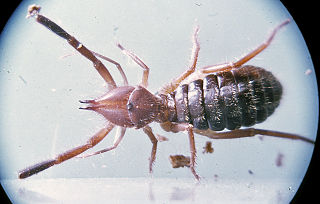 W
WBartholomea annulata is a species of sea anemone in the family Aiptasiidae, commonly known as the ringed anemone or corkscrew anemone. It is one of the most common anemones found on reefs in the Caribbean Sea.
 W
WGluvia dorsalis is the only species of solifugid which lives in Spain and Portugal. It is reported to be a common species on the streets of Madrid.
 W
WNarceus americanus is a large millipede of eastern North America. Common names include American giant millipede, worm millipede, and iron worm. It inhabits the eastern seaboard of North America west to Georgetown, Texas, north of the Ottine wetlands. It has a nearly cylindrical gray body, reaching a length of 4 inches (100 mm). When threatened, they sometimes curl up or release a noxious liquid that contains large amounts of benzoquinones which can cause dermatological burns. This fluid may irritate eyes or skin. Many other millipedes secrete hydrogen cyanide, and while there have also been claims that N. americanus releases hydrogen cyanide, this is not true. They do however, excrete a substance that causes a temporary, non-harmful discoloration of the skin.
 W
WParanthus rapiformis, the onion anemone, is a species of sea anemone in the family Actinostolidae. It was first described by the French naturalist Charles Alexandre Lesueur in 1817 and is native to the northwestern Atlantic Ocean and the Gulf of Mexico.
 W
WPhymanthus crucifer, commonly known as rock flower anemone, flower anemone, red beaded anemone or the beaded anemone, is a species of sea anemone in the family Phymanthidae. It has been described as "closely similar" to Heteractis aurora in several ways, commonly exhibiting "tentacles with swollen cross-bars" bearing large clusters of stinging nematocysts. However, P. crucifer may also be found with smooth tentacles, sometimes in the immediate vicinity of a swollen-crossbarred specimen.
 W
WSternaspis scutata is a species of marine polychaete worm in the family Sternaspidae. It occurs in the Mediterranean Sea and the temperate northeastern Atlantic Ocean. It lives submerged in mud or other soft sediment.
 W
WStrigamia maritima is a centipede belonging to the family Linotaeniidae in the order Geophilomorpha. It is the most common of the four fully coastal geophilomorph species known in the British Isles.